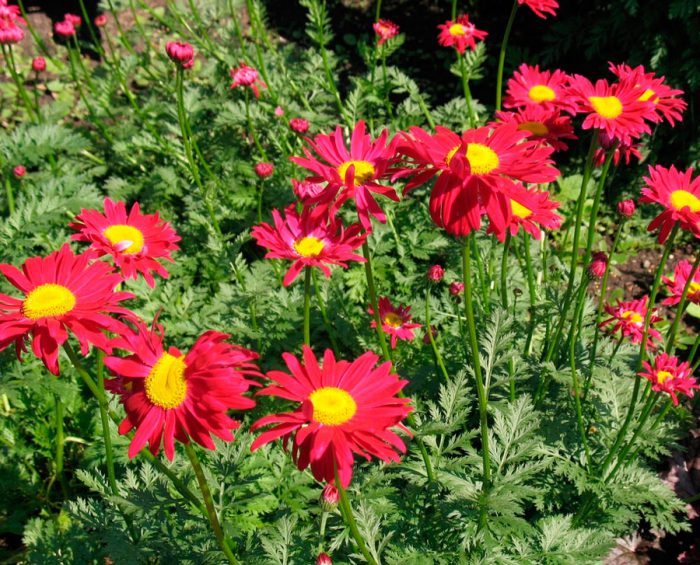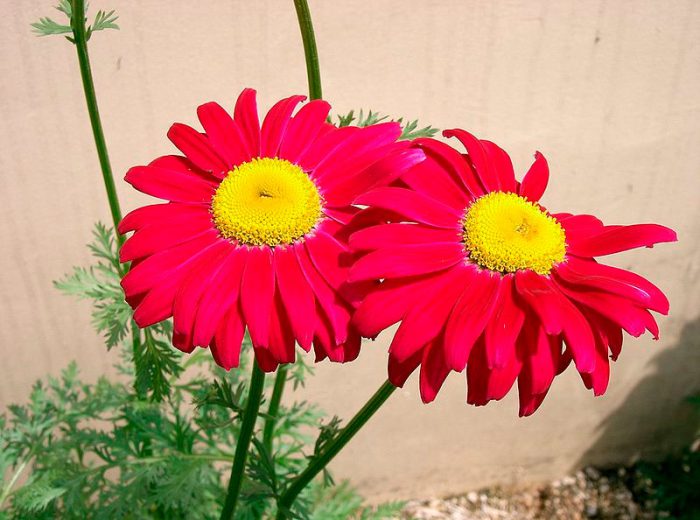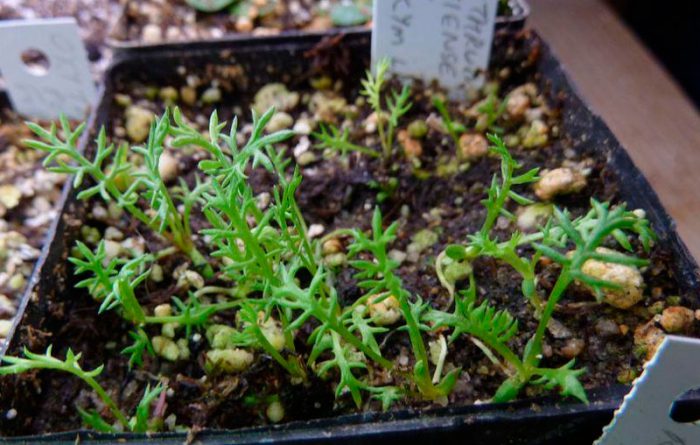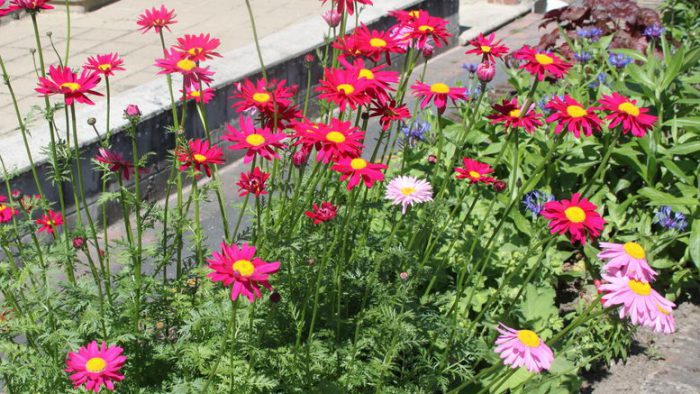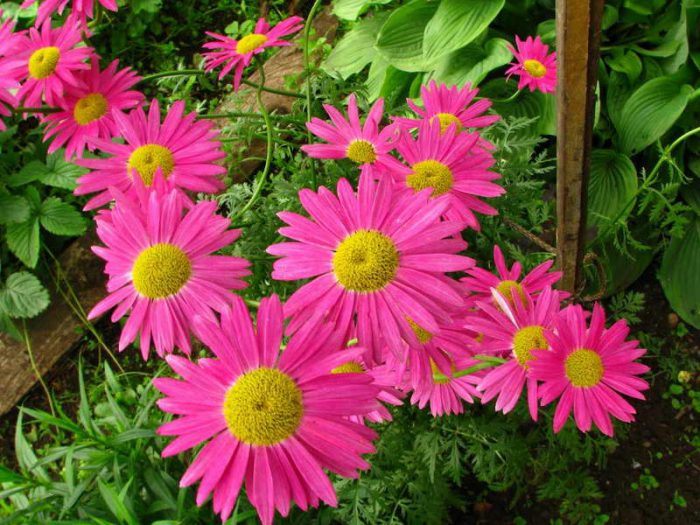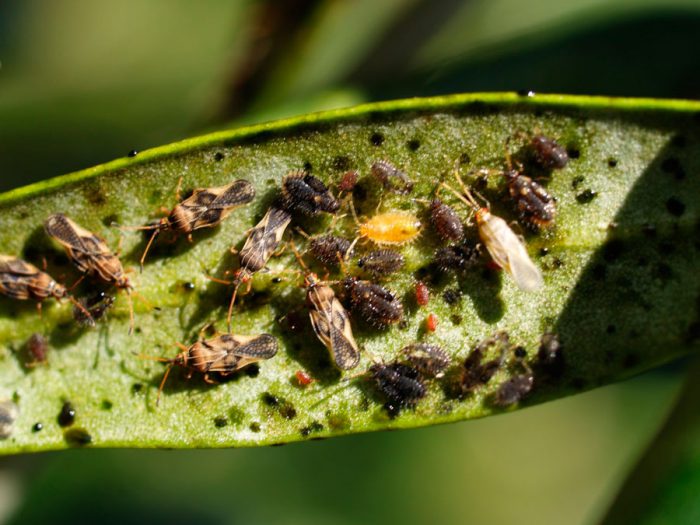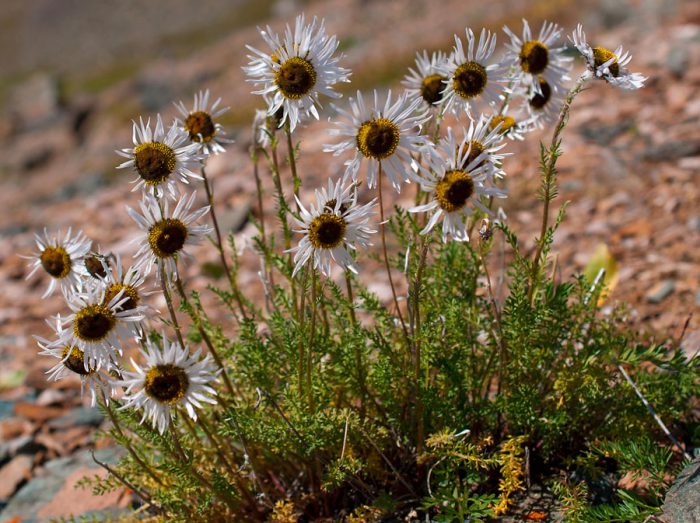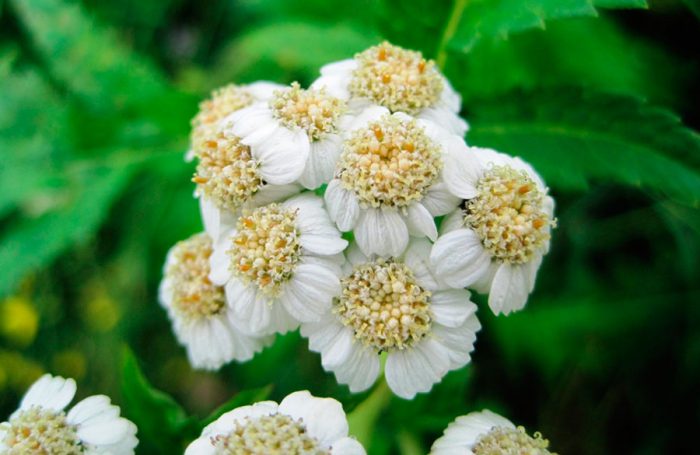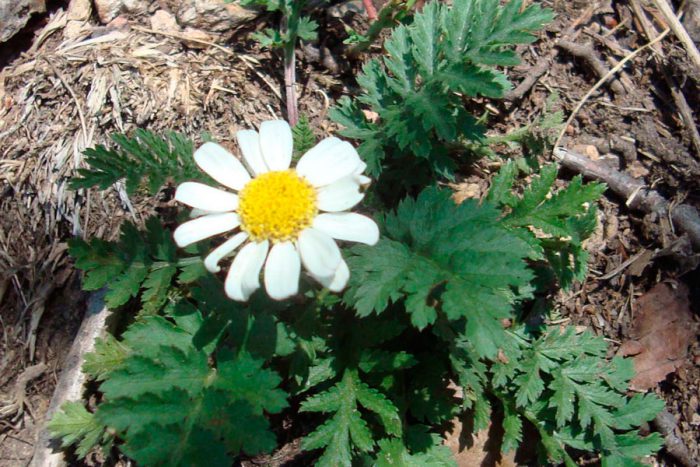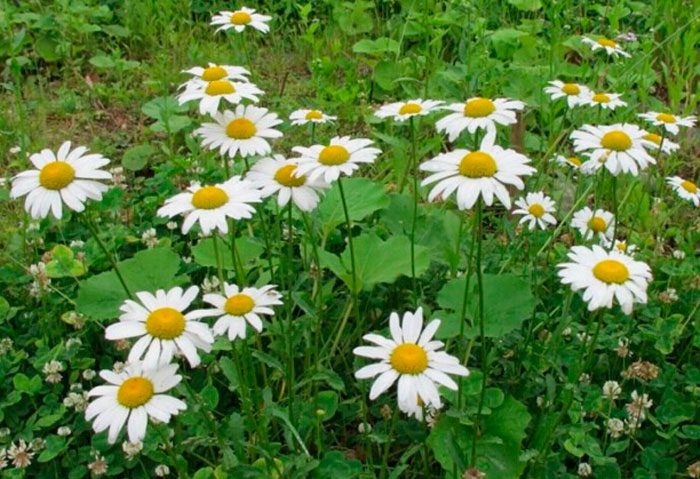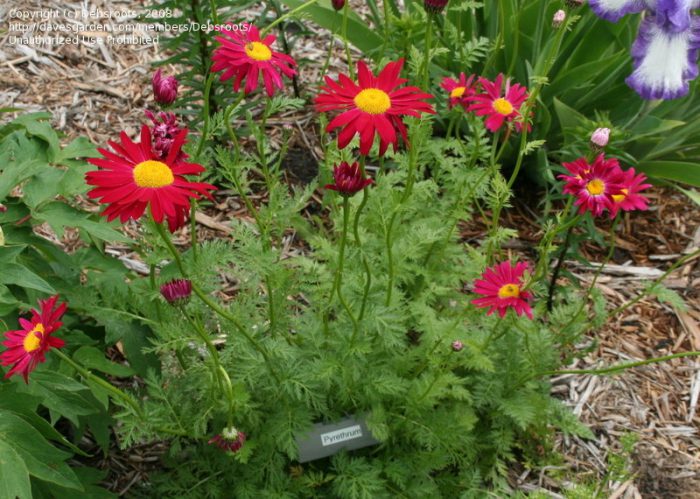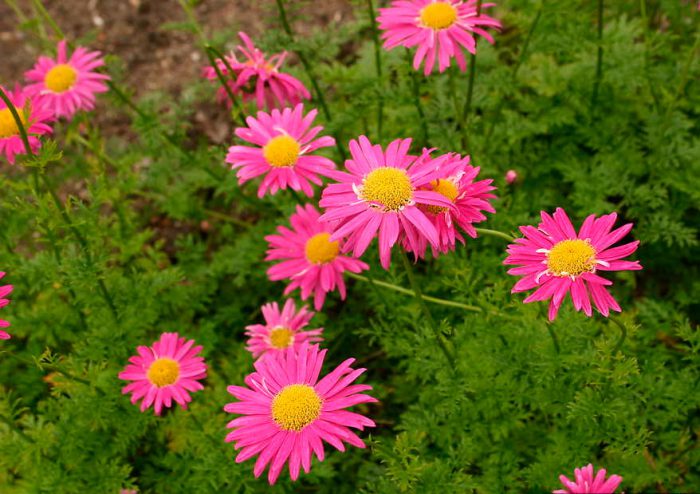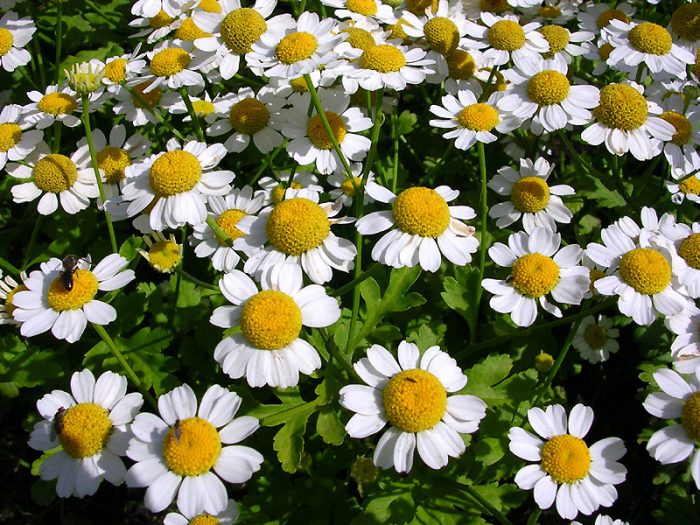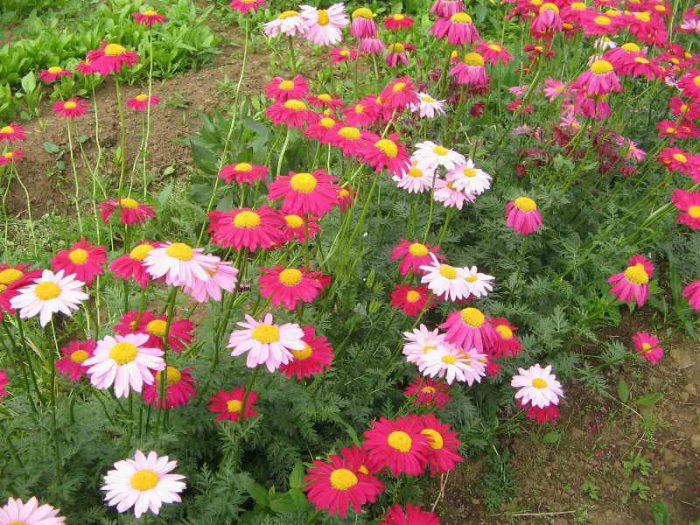The herbaceous perennial plant pyrethrum (Pyrethrum) is a member of the family Asteraceae, or Asteraceae. This genus unites about 100 species. All these species have one common feature - the color of the reed flowers is white or pink. This plant comes from Europe, Asia and North America. This plant got its scientific name due to the fact that some species have healing properties, or rather, they are able to lower body temperature ("pyretos" means "fever, fever"). Among the people, such flowers have other names, for example: chamomile, popovnik or chamomile.
Content
- 1 Features of pyrethrum
- 2 Planting pyrethrum in open ground
- 3 Caring for feverfew in the garden
- 4 Types and varieties of pyrethrum with photos and descriptions
- 4.1 Pyrethrum beautiful (Pyrethrum pulchrum = Tanacetum pulchrum)
- 4.2 Large-leaved pyrethrum (Pyrethrum macrophyllum = Tanacetum macrophyllum = Chrysanthemum macrophyllum)
- 4.3 Pyrethrum corymbosum (Pyrethrum corymbosum = Chrysanthemum corymbosum = Tanacetum corymbosum)
- 4.4 Pyrethrum cinerariifolium, or Dalmatian chamomile
- 4.5 Pyrethrum red (Pyrethrum coccineum = Chrysanthemum coccineum), or Caucasian chamomile
- 4.6 Pyrethrum roseum, or Persian chamomile
- 4.7 Feverfew (Pyrethrum parthenium = Chrysanthemum parthenium = Tanacetum parthenium)
- 5 Properties of pyrethrum: harm and benefit
Features of pyrethrum
Most types of pyrethrum are perennials. Among the many species, there are also annuals. Ribbed branched shoots can be erect or ascending, there is pubescence on their surface. The height of the stems is 0.6–1 m. Such plants have a very powerful root system, which can penetrate 300 cm deep into the ground. Alternate leaf plates are dissected into narrow segments of various widths. Their front side is green-gray, and the wrong side is gray-ash. The basal leaf plates have grooved petioles, they are a couple of times longer than the leaves themselves. The stem leaf plates also have petioles, which become shorter as they approach the top of the shoot. The diameter of single baskets is from 50 to 60 mm, they are part of the corymbose apical inflorescences. The structure of the baskets includes reed barren marginal and small bisexual median tubular flowers, which are painted in white, red and in all shades of pink. Flowering occurs in May and June. The fruit is a pale brown achene with 5 to 10 ribs, their crown is serrated or lobed. The seeds remain viable for 2 or 3 years.
Planting pyrethrum in open ground
Growing pyrethrum from seeds
If you collect seeds from pyrethrum yourself, then the flowers grown from them will not retain the varietal characteristics of the parent plant. In this regard, if you want the flowers you have grown to be of a certain variety or color, then the purchase of seeds should be made in a garden pavilion or in a special store.
The seeds of such a plant are very small, therefore, in order to facilitate sowing, it is recommended to combine them with sand. Sowing is carried out in the first days of March, while the seeds must be buried in the soil by about 0.3–0.5 cm. There is another simpler planting method, for this the seeds are spread over the surface of the soil mixture, after which they are covered with the necessary amount of soil from above. Crops should be watered using a fine-dispersed spray bottle. The container must be covered with foil or glass, and then it is removed to a well-lit and warm (18 to 20 degrees) place. After the first seedlings appear from the container, you will need to remove the shelter. A pick in individual pots or cups is carried out after the second true leaf plate begins to develop in the plants. Before transplanting feverfew into open ground, it must be hardened for 15 days.
Such a flower can be grown in a seedless way, but only in the southern regions. Sowing seeds in open soil is carried out in the first days of September.


Watch this video on YouTube
How to plant in the garden
Naturally growing pyrethrum plants prefer nutrient-rich soil. In this regard, and when grown in a garden plot, they will need fertile, loose and permeable soil. It is impossible to grow such a flower on poor, sandy or dry soils, and a low-lying area where there is stagnant water is also not suitable for planting it, because this plant reacts extremely negatively to prolonged waterlogging, especially if it is cold outside. The most suitable site for planting such a plant would be one that is illuminated by the sun for only a few hours a day, and it should be in shade for most of the day.
When planting between plants, a distance of 25-30 centimeters should be observed. Planted feverfews need abundant watering, while the first 1.5 weeks after planting they will need shading from direct sunlight. Perennial pyrethrum begins to bloom the next year after planting.
Caring for feverfew in the garden
Caring for feverfew is very simple. This perennial is perfect for those who do not always have time to take care of garden flowers. After the flowers get stronger after transplanting, they will not be afraid of any weeds, because they will be able to suppress their growth. In this regard, it will be necessary to weed a flowerbed with pyrethrum only at the very beginning of the growing season, while in order to reduce the number of weeding, the soil surface can be covered with a layer of mulch (organic matter). In order for the plant to grow well and develop correctly, it needs systematic watering. After the flowers are watered, it is recommended to loosen the soil surface, this will help to avoid the formation of a dense crust on it.
For feeding, both organic matter and mineral fertilizers are used. It is impossible to overfeed pyrethrum with nitrogen, since in this case it will intensively increase the green mass, and flowering will become scarce. The flower responds well to rotted manure.
The shoots of the bushes are tall, but not very strong, so they may need a garter. When the first flowering ends, it is recommended to remove all peduncles, without waiting for the start of seed formation. In this case, in the last weeks of the summer period, feverfew will begin to bloom again. Without a transplant, such flowers can be grown in the same place for no longer than four years. During this time, they will grow strongly, because of which the flowering will become scarce. Therefore, every 4 years, such flowers are recommended to be transplanted to a new place. The transplanted bushes are divided if necessary.
Diseases and pests
Feverfew is distinguished by a fairly high resistance to various diseases and pests. However, in rare cases, he can get sick. For example, this flower sometimes suffers from fusarium or gray rot.A fungal disease such as gray rot damages those parts of the bush that are located above the ground, as a result of which a fluffy bloom of gray color appears on their surface, their deformation occurs, and as a result the bush dies. Affected plants are removed from the soil and destroyed, and the area on which they were grown must be spilled with a solution of any fungicide. Fusarium is also an infectious fungal disease. Its pathogens enter the plant through the roots, while the vascular system of the flower is primarily affected. An infected bush cannot be cured; therefore, it must be removed from the ground and destroyed, which will avoid further spread of the infection. The soil, as well as the remaining bushes, should be treated with a fungicide, which contains copper.
Thrips, slugs, and also aphids can greatly harm such a plant. Slugs are very fond of feverfew foliage, and you have to collect them by hand. To quickly get rid of slugs, you can attract birds or hedgehogs to your site. Thrips often settle on feverfews. It is impossible to get rid of them, therefore, it is recommended to remove the bush inhabited by such pests from the soil and destroy, and the surface of the site and the remaining plants must be sprayed with a systemic insecticide. If aphids have settled on such a flower, then it is also recommended to get rid of such a plant, however, if you wish, you can try to cure it, for this the bush is treated with an insecticide, for example: Aktara, Biotlin, Aktellik or another means of similar action. As a rule, it is not possible to destroy all aphids the first time, therefore, in order to finally get rid of such pests, you will need to process the plant at least 2 or 3 times.
After flowering
When the plant fades in autumn, its part, located above the ground, must be cut flush with the surface of the site. Before wintering, the surface of the site should be covered with a layer of mulch (peat) or covered with spruce branches. If the plants are covered for the winter, then they will not be afraid of any frosts. After the onset of the spring period, the spruce branches are removed from the site, and the mulch is raked off, this will allow young shoots to quickly break through the soil.
Types and varieties of pyrethrum with photos and descriptions
Not a very large number of pyrethrum species are cultivated by gardeners. But it should be borne in mind that such a flower has a very large number of different varieties and garden forms.
Pyrethrum beautiful (Pyrethrum pulchrum = Tanacetum pulchrum)
This species can be found in natural conditions in Northern China, Kazakhstan, Central Asia, Northern Mongolia and Siberia. Such a flower prefers to grow in the tundra, on rocky placers and slopes near glaciers. This perennial plant is rhizome and semi-rosette, it reaches a height of about half a meter, on the surface there is a pubescence, consisting of twisting hairs. Few low leafy shoots are erect. Green basal leaf plates have long petioles, they are doubly pinnately dissected, may be naked or have sparse pubescence. The length of such leaves is about 15 centimeters, and the width is 2 centimeters. Stem leaf plates are sessile. Baskets can be single or be part of inflorescences in 2 or 3 pieces. The baskets include gray tubular flowers and white reed flowers.
Large-leaved pyrethrum (Pyrethrum macrophyllum = Tanacetum macrophyllum = Chrysanthemum macrophyllum)
The birthplace of this perennial plant is the Caucasus. The height of such flowers can vary from 1 to 1.5 m. The diameter of the corymbose inflorescences is about 10 centimeters, they consist of small white flowers. When the plant begins to fade, its baskets will change color to brown-red.This flower looks great in large groups, while it is recommended to combine it with rod-shaped millet, variegated miscanthus, reed grass, as well as other decorative cereals.
Pyrethrum corymbosum (Pyrethrum corymbosum = Chrysanthemum corymbosum = Tanacetum corymbosum)
This species comes from the Caucasus, Eastern Europe and the Altai foothills, while it prefers to grow in dry meadows. This perennial rhizome plant has several or only one, branched at the top, upright shoot, the height of which can vary from 0.4 to 1.5 m. pinnately dissected. Stem leaf plates are outwardly similar to basal ones, but they do not have such long plates, while the upper and middle leaves are sessile, and the lower ones are petiolar. Loose corymbose inflorescences consist of 15-20 baskets, located on rather long hairy legs. Achenes are gray, and ligulate flowers are white. Blooming is observed in June.
Pyrethrum cinerariifolium, or Dalmatian chamomile
The height of such a herbaceous plant can vary from 0.15 to 0.45 m. The gray-silvery leaf plates can be double or triple pinnately dissected. In the baskets, the achenes are gray, and the marginal flowers are light yellow or white.
Pyrethrum red (Pyrethrum coccineum = Chrysanthemum coccineum), or Caucasian chamomile
This flower is often mistaken for pink feverfew. Under natural conditions, this species can be found in the Caucasus. It has a large number of different forms with ligulate flowers, painted in different colors from dark cherry to white. Quite often, among them there are forms with terry baskets. Unlike pyrethrum pink, pyrethrum red has double pinnately dissected leaf plates. In the parts of such a plant, located above the ground, there are substances that are poisonous to pests and absolutely harmless to humans and warm-blooded animals.
Pyrethrum roseum, or Persian chamomile
The homeland of this species is also the Caucasus. This species has been cultivated by humans for over 200 years. Shoots are erect, their height can vary from 0.6 to 0.7 m. Pale green rosette leaf plates grow on petioles and are dissected. Stem leaf plates are not as large as basal ones. The diameter of the baskets is about 50 mm, they are 2 or 3 pieces collected in brushes, but there are also single ones. The color of the tubular flowers is yellow, and the reed flowers are pink. This species has a large number of different varieties and forms, which are most often called hybrid pyrethrum. Among this variety, there are plants with terry baskets, which are painted in white, dark red or pink. The Robinsons mix group of hybrids is the most common, such plants have a height of about 0.8 m, the diameter of their pink or red baskets is about 12 centimeters. The most popular are the following varieties of hybrid pyrethrum:
- Atrosanguinea. The height of the bushes is about 0.6 m, while the inflorescences in diameter can reach 60 mm. The color of the tubular flowers is yellow, and the reed flowers are dark red.
- Brenda. Reed flowers have a deep pink color.
- James Kelway. The height of the bush is about 0.6 m, the diameter of the baskets is about 60 mm. The color of the marginal flowers is scarlet-red.
- I.M. Robinson. The marginal flowers are pinkish.
- Kelvey Glories. The tubular flowers of this plant are yellow, and the reed flowers are scarlet.
- Lord Rosebury. This variety has dense double baskets.
- Vanessa. Terry baskets, yellow center is convex.
Popular garden forms of pyrethrum pink: pink, red, double pink, low and double white.
Feverfew (Pyrethrum parthenium = Chrysanthemum parthenium = Tanacetum parthenium)
Of all the annual pyrethrum, this species is the most popular. His homeland is Southern Europe. Under natural conditions, such a plant is perennial, like those whose description can be found above, but by gardeners it is cultivated as an annual. The height of the compact bush is about half a meter, it is strongly branched. Greenish or green-yellow petiolate leaf plates can be pinnately dissected or deeply cut, there is pubescence on their surface. Apical racemose inflorescences consist of small baskets, the diameter of which is 15-30 mm, they can be double or simple. Reed flowers are yellow or white. The most popular garden odds are yellow-leaved (large-lobed leaf plates are pale yellow in color, marginal flowers are white) and disc-shaped (this border plant has marginal yellow flowers). Varieties with terry spherical inflorescences are very popular, for example:
- Zilbeoteppich. Spherical terry baskets are painted white.
- Schneebal. The height of the bush is from 0.2 to 0.25 m, the leaf plates are pale green, the diameter of the double white inflorescences is about 25 mm, they contain only tubular flowers.
- Dahl White. Inflorescences of white color are outwardly similar to buttons.
- Snow Puffs, Snow Ball and White Stars. These varieties have round inflorescences, which have skirts, consisting of short wide ligulate flowers.
- Virgo. The height of the bush is 0.8 m. Terry spherical baskets of white color have a diameter of only 15 mm.
- Goldbal. The diameter of the yellow double inflorescences is 25 mm, they contain only tubular flowers.
Properties of pyrethrum: harm and benefit
Useful properties of pyrethrum
In ancient times, feverfew was widely used to reduce body temperature, eliminate inflammation and head pain. Aspirin and feverfew have similar properties. Already in the 17th century, English scientists officially announced that this plant has healing properties. In those days, it was used as a remedy for head pain. In the eighties of the twentieth century, English scientists discovered that this flower can relieve migraines, from which a large number of people suffer. The powder made from the foliage of this plant helps to get rid of migraines much faster and more effectively than other medicines. The fact is that parthenolide is part of the pyrethrum, it helps to block the production of serotonin by the pineal gland. It is known that it is the excess of serotonin in the vessels and cells of the brain that is the cause of the development of a migraine attack.
Drugs such as Lizurit and Metisergide also help with migraines well, but when they are taken, various unwanted side effects are observed. Feverfew is devoid of such a disadvantage. In addition, this plant helps to block the production of histamine, does not allow blood clots to form in blood vessels, and has antimicrobial and antiallergic effect. The foliage is used for rheumatism and arthritis, asthma attacks and pain during menstruation. In combination with other medicines, this plant is used to treat allergies, psoriasis and dermatitis.
Harm
Feverfew should not be taken by women who are carrying a child and nursing soils, children under two years of age, people taking coagulants and having an individual intolerance.


Watch this video on YouTube

